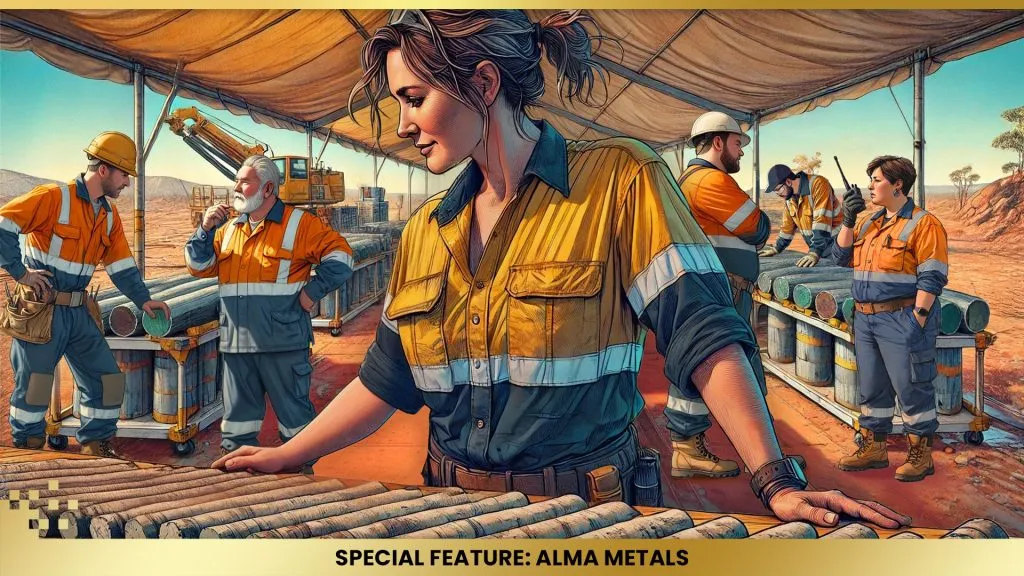June 6, 2025

This article is a sponsored feature from Mining.com.au partner Alma Metals. It is not financial advice. Talk to a registered financial expert before making investment decisions.
Alma Metals (ASX:ALM) is checking the boxes at its Briggs Copper Project in Queensland as the world heads towards a significant copper supply-demand gap.
The most recent achievement was an upgrade in the confidence of the resource to include the indicated category, which provides greater certainty around the grade and tonnages and better supports mine planning and an assessment of a project’s economic viability.
The total resource of 439 million tonnes @ 0.25% copper is now broken down into 110 million tonnes @ 0.27% in the indicated category and 329 million tonnes @ 0.24% in the inferred category.
The indicated component increases the potential for a higher grade starter pit.
The overall grade of the resource also stacks up against other projects in the pipeline, including Caravel Minerals’ (ASX:CVV) Caravel Project in Western Australia, which has a resource of 1.276 billion tonnes @ 0.24% copper and Harmony Gold Mining’s (NYSE:HMY) 366-million-tonne @ 0.4% copper Eva Project in Queensland.
There is also Alkane Resources’ (ASX:ALK) Boda-Kaiser Project in New South Wales, which hosts a resource of 796 million tonnes @ 0.42% copper equivalent – though this is largely a gold project.
Briggs is a porphyry deposit, a large source of copper, accounting for over 60% of global supply of the red metal, as well as other important metals such as molybdenum, gold and silver. Although low grade, these deposits are extremely high tonnage which provides economic benefits of scale.
Managing Director Frazer Tabeart tells Mining.com.au Briggs’ resource is at surface, and with a higher grade core zone has the potential to positively impact economic modelling, providing Alma a clear advantage in early stage mining.
“Alma’s metallurgical recoveries – up to 95% copper – at coarse grind sizes also compare very favourably, potentially lowering capital and operating costs,” he explains.
The April resource upgrade also incorporated for the first time a silver byproduct.
Untested targets provide expansion potential
The current resource estimate covers just a portion of the Briggs Central Porphyry and is only restricted by the amount of drilling completed so far.
Multiple high-priority copper-in-soil anomalies remain untested, particularly on the higher-grade western side of the overall system, and recent drilling of the Southern Porphyry has confirmed copper mineralisation, suggesting room for additional resource areas.
This all points to significant upside in terms of both grade uplift and tonnage expansion, according to Tabeart.
“Further infill and extensional drilling is planned for H2 2025, targeting conversion of inferred to indicated resources and stepping out beyond the current mineral resource estimate footprint,” he says.

Alma is also working towards the completion of a Scoping Study by mid-2025.
While the Caravel, Alkane and Harmony projects are all at a more advanced stage of development than Briggs, their valuations highlight the upside potential for emerging copper producers like Alma.
Caravel’s share price is sitting around $0.17, having advanced nearly 26% since late April. Alkane, meanwhile, is trading at about $0.77, with a rally of over 45% since the start of 2025 and the explorer now in the process of merging with Canada’s Mandalay Resources (TSX:MND) to create a plus-$1 billion company.
By comparison Alma’s shares are trading at $0.003, giving the company a market capitalisation of around $5.55 million and indicating some steep upside given the comparable projects discussed.
The enterprise value of the company, calculated by adding the market capitalisation to the debt and subtracting the cash on hand, values Alma’s assets at around $4.6 million versus Caravel’s $93.8 million and Alkane’s $467.7 million.
“Briggs is at an earlier stage than its peers, and this is reflected in the current share price which highlights that Alma is carrying a much lower enterprise value for Briggs than peer project valuations. This highlights the opportunity for investors seeking longer term exposure to the bullish copper market,” Tabeart explains.
Also of note is the acquisition of MAC Copper by Harmony Gold, announced in late May 2025, which valued MAC at about $1.6 billion.
MAC Copper owns the operating CSA Copper Mine in Cobar, New South Wales. Whilst a smaller project compared to Briggs, the transaction demonstrates the appetite of big players to acquire de-risked copper assets ahead of what is anticipated to be a looming supply crunch in the years to come.
This is further supported by a significant jump in mergers and acquisitions activity for copper in recent months, including the proposed sales of Xanadu Mines’ (ASX:XAM) Kharmagtai project in Mongolia and New World Resources’ (ASX:NWC) Antler copper project in Arizona.
Copper shortfall creates window of opportunity
Alma anticipates it could enter production in a period where there is a deep copper supply shortage and high demand from the accelerating electrification of the globe.
In a May report, the International Energy Agency (IEA) highlighted major concerns over the supply-demand trajectory for copper.
While there is unprecedented demand for the red metal due to it playing a major role in both the clean energy transition and the rapid rise of artificial intelligence and data centres, the IEA says the current mine project pipeline points to a potential 30% supply shortfall by 2035 due to declining ore grades, rising capital costs, limited discoveries and long lead times.
“In the case of copper, the rapid expansion of grid investments in China has been the single largest contributor to demand growth over the past two years,” the IEA notes in its report.

This has prompted price forecasts from Goldman Sachs of US$10,000 to US$12,000 per tonne in the next few years, while Fitch BMI sees copper hitting US$17,000 a tonne by 2033.
“Alma expects to enter production into this forecast deficit window, making it well timed to meet global demand growth as major global operations face delays, declining grades and permitting challenges,” Tabeart says.
Briggs is still in the early stages of its permitting and approvals pathway, as it advances through the Scoping Study in 2025.
However, Alma is about to begin early stage baseline environmental work, and a detailed permitting pathway has been mapped out for the project to take into account project specifics.
Tabeart says Briggs’ simple mineralogy, strong metallurgy and location support a clear, achievable permitting path.
The project is located 60km from the Gladstone deepwater port, with high-voltage power lines, multiple gas pipelines, major highway and rail access within 15km of the deposit.
Surface mineralisation with a very low strip ratio also makes it ideal for low-cost open-pit development.
Given the earlier stage of the project, no offtake agreements have been announced yet, but Tabeart says the high copper recoveries and clean concentrate quality achieved through metallurgical testing “significantly enhance offtake appeal” to both domestic and international buyers.
“Alma will assess offtake and partnership options as it advances toward feasibility,” he adds.
The imminent Scoping Study will create the foundation for a Prefeasibility Study and further development steps.
Alma is presenting at the Noosa Mining Investor Conference running from 23 to 25 July at the Peppers Noosa Resort. Mining.com.au is an official media partner of the event. To register click here.
